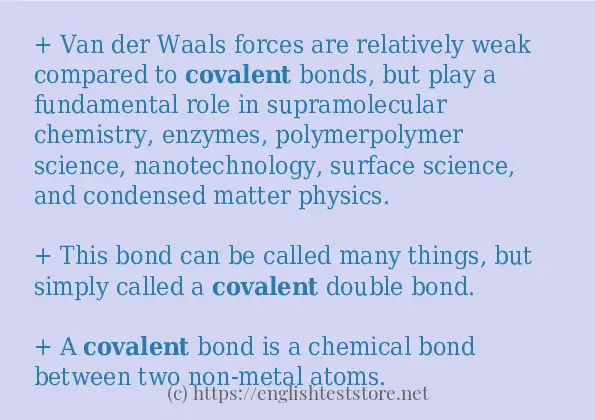How to use in-sentence of “covalent”:
+ Van der Waals forces are relatively weak compared to covalent bonds, but play a fundamental role in supramolecular chemistry, enzymes, polymerpolymer science, nanotechnology, surface science, and condensed matter physics.
+ This bond can be called many things, but simply called a covalent double bond.
+ A covalent bond is a chemical bond between two non-metal atoms.
+ Ceramics and glasses use covalent bonds and ionic-covalent bonds with SiO, silica or sand, as a fundamental building block.
+ They are similar to covalent bonds.
+ If connected by a covalent bond they are a “prosthetic group”.
+ It has covalent bonds in it and melts easily.
+ It is the strongest one of the covalent type.

Example sentences of “covalent”:
+ Molecular covalent bonds can be described as polar or nonpolar.
+ Semiconductor has four valence electrons, when it is doped with pentavalent impurity the four valence electron makes covalent bond and the remaining one is now free to move, this is how n-type doping increases conductivity of the semiconductor.
+ For example, mercury ions form covalent metal-metal bonds.
+ Molecular covalent bonds can be described as polar or nonpolar.
+ Semiconductor has four valence electrons, when it is doped with pentavalent impurity the four valence electron makes covalent bond and the remaining one is now free to move, this is how n-type doping increases conductivity of the semiconductor.
+ For example, mercury ions form covalent metal-metal bonds.
+ Organic compounds contain carbon bonds in which at least one carbon atom is covalent bondcovalently linked to an atom of another type.
+ A water molecule consists of one oxygen atom and two hydrogen atoms held together by a covalent bond.
+ The inertness of nitrogen is due to the presence of the very strong triple covalent bond in the N molecule.
+ In 1922, Hermann Staudinger proposed that polymers were long chains of atoms held together by covalent bonds.
+ The hydrogen and carbon are bonded with non-polar covalent bonds.
+ The formation of stable Covalent bondcovalent chemical bonds between the monomers sets polymerization apart from other processes, such as crystallization, in which large numbers of molecules aggregate under the influence of weak intermolecular forces.
+ In chemistry, bond length is the measure of the size of a covalent bond.
+ Because of its lack of polar covalent bonds, hydrocarbons cannot create hydrogen bonds with water and are hydrophobic.
+ The arsenic trichlorides are low melting covalent solids.
+ The amino acids are held together by a specific type of covalent bond, known as a peptide bond, which are made during the process of protein biosynthesis or translation.
+ Redox reactions can also happen by sharing electrons to form a product by covalent bonding.
+ In chemistry, a delocalized electron is an electron in a molecule, ion or solid metal that is not associated with a single atom or a covalent bond.
+ Each atom is shown by a letter, and connected by a line to each atom with which it is has a covalent bond.
+ Lipopolysaccharides, also known as lipoglycans, are large molecules made of a lipid and a polysaccharide joined by a covalent bond.
+ To calculate Pauling electronegativity for an element, the data on the dissociation energies of at least two types of covalent bonds created by the element is needed.
+ This is called a covalent bond.
